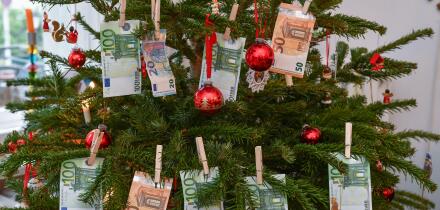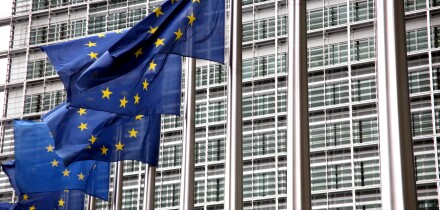
“We have seen a big shift post-crisis in the breakdown of the CP market — in tenors, currencies, issuer type,” says Marnix Bruning, head of money market and central bank sales at ING Bank in Amsterdam.
Despite these changes, market volume has held up. Outstandings now stand a little below $500bn, according to Dealogic. The end-March total of $470bn compares to $476bn at the end of 2013.
With rates so low, the stability is striking. “Four years ago we might have expected outstandings to decline much further than they did. But ECP is one of the markets benefiting from so much liquidity in euros and few alternatives for investors — banks aren’t interested in cash,” says Bruning.
ECP’s reinvention has brought a flight to quality. Almost two-thirds of average 2017 outstandings carry the top short-term credit ratings of A1+/P1, according to Dealogic, while 16% is rated A1/P1. A further 5% is either A1+/A1 grade or P1.
This domination of flows by the strongest credits shows up in the market’s issuer profile too. Since the global financial crisis the sovereign, supranational and agency sector has overtaken banks as the product’s leading user by volume.
Sovereign and agencies now make up the largest single group of ECP issuers, with 42% of average 2017 outstandings, Dealogic data shows. Supranationals, whose sales powered to a record $113bn last year, bring the SSA share close to 50%.
Banks are now just a third of the market — a decline from their peak share that reflects the sector’s effort to extend funding maturities and match-fund its asset base as Basel III dictates. The availability of cheap ECB funds under the LTRO initiatives has further affected bank appetite for issuing the product.
Against this background, banks’ ECP outstandings have lagged the sovereign/agency category every year-end since 2010, apart from 2014 — and at every quarter-end since Q3 15.
A related development has been the rise of dollar sales. “You would expect euros to be the largest ECP currency, but in the last 18 months dollars has taken over,” says ING’s Bruning.
Dollars contributed 41.7% of total volume last year, versus euros at 37.8%.
This reflects European SSAs seeking to benefit from the favourable €/$ basis swap. Leading borrowers from the sector such as ACOSS (Agence Centrale des Organismes de Securité Sociale), European Investment Bank, FMS Wertmanagement, KfW and Sweden issue in dollars at around Libor flat and achieve post-swap funding of some Euribor minus 30bp.
Their dollar paper attracted investors, particularly from non-European central banks and sovereign wealth funds.
Almost all SSA ECP is now sold in dollars. Some dealers say it has a 95% share.
In contrast, euro demand fell back after rates turned negative. It dominates the shortest-dated sector, however, having claimed half or more of sub-30 day volume for several years. This is reflected in many more ECP transactions. Last year there were 13,085 trades in euros versus 8,271 in dollars, despite dollars’ substantial lead in total market share. The Netherlands, a top 10 issuer by total volume, is a key component. It uses the market for intra-month liquidity management.
Corporate ECP is regaining momentum. “Outstandings even grew a bit” in recent years, says Bruning at ING.
Dealogic data shows the sector accelerating from average outstandings of around $50bn in 2013 and 2014 to some $70bn last year. While names such as Enel, Porsche, Telefónica and Toyota remain leading issuers, North American companies are an increasing presence in the market. With these firms’ domestic source of short-term funding having become more challenging with their main buyers’ recent overhaul, a number of blue chips have entered the ECP market.
New arrivals include Avery Dennison, Fortive, Stanley Black & Decker, Thermo-Fisher Scientific and United Technologies, as well as Canada’s Magna. Moreover, established US issuers like Caterpillar and Colgate-Palmolive have stepped up, while Danaher and Honeywell each entered the top eight corporate issuers by total volume last year. The former entered the top three (behind compatriots General Electric and Procter & Gamble) in Q1 17.
“We’ve seen a lot of corporates looking to diversify away from the US due to the money market fund reform and tap into relatively cheap cash in the ECP market,” says Bruning.
The corporate acceleration even extends to growing appetite for unrated names — both in ECP and the French domestic product (the recently-renamed NEU CP, previously billets de Tresorie, BdT). Key issuers include Adidas and Rallye.
MMF momentum
Despite ultra-low rates, inflows into European money market funds (MMFs) remain strong — underpinning the ECP market, where they are the largest buyers. In Q1 17 sterling prime funds attracted over £6bn of new money (a 4.4% rise in assets under management), while euro prime funds attracted more than €3bn (+4.6%), according to Moody’s.
These rises were “likely a result of few comparably secure alternatives amid heightened uncertainty from elections in the Netherlands and France, and the UK initiating the process of leaving the European Union,” says Vanessa Robert, senior credit officer at Moody’s in Paris.
French MMFs stand out as the more flexible sub-set of these key buyers of ECP. They operate floating NAVs and will buy in tenors out to two years.
“They have a huge appetite to extend maturity and are very keen to buy corporates — even unrated,” says ING’s Bruning.
In contrast, UK constant NAV, single-currency MMFs (often triple A-rated) are highly restricted. Demand from this category underpins the sterling sector. ECP sales claim between 25% and 18% of the market each year, with annual sales consistently above $400bn-equivalent.
Asset managers are the largest buyers, followed by central banks and sovereign wealth funds. Insurers and pension funds are also involved to a more limited extent.

Just as corporate issuers have become more active, so their treasuries are stepping up ECP purchases. French firms have always been investors in the product (and of domestic paper), but Dutch, German and Swiss companies and US subsidiaries in Europe are all buying more too.
“The bigger and more professional corporate treasuries are looking for alternatives versus money market funds and bank deposits. Their cashflow predictions are more refined, so they are better able to extend the maturities of their investments, where before it was very easy to get good rates on short term bank deposits or money market funds,” says Bruning.
The asset-backed sector accounts for much of ECP’s post-crisis plunge in volume. It was as much as 25% of total outstandings at its pre-crisis peak, but now constitutes less than 10%. At the end of Q1 17 $34.9bn of AB ECP was outstanding — 7.5% of the total ECP market.

With opportunities for regulatory arbitrage diminished by the shift of bank assets back on to balance sheets, single-seller conduits have disappeared from ECP. Only multi-seller conduits that refinance third-party assets remain (plus the repo category, which invests the proceeds of issues in repos with highly rated banks).
Multi-seller conduits mostly repackage trade receivables, auto loans and leases. These three asset types constitute almost two-thirds of outstandings, according to Moody’s. AB ECP is also refinancing smaller volumes of residential mortgages, commercial, consumer and student loans, and credit card receivables.
A second big change is the departure of ‘partially supported’ conduits. “In 2016 the last partially supported European conduit was converted to full support, meaning that European ABCP investors are no longer exposed to any asset or seller risk,” says Carine Kumps-Feniou, senior analyst at Moody’s in London.






